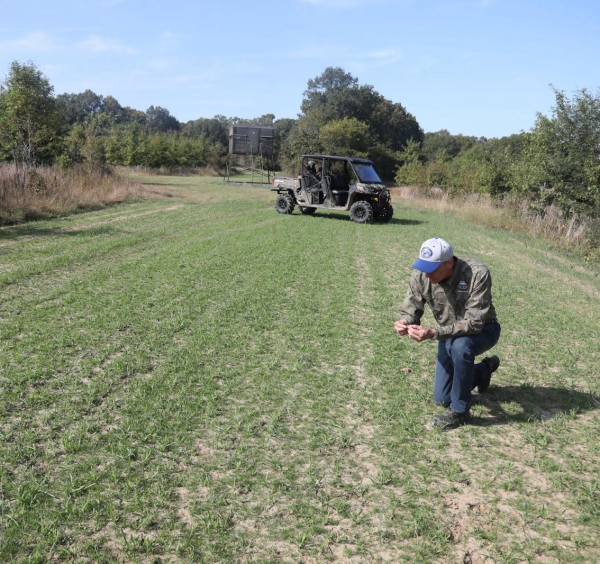Six Tips for Drought Proofing Your Food Plots
 Despite the ample rain we’ve seen through much of the country, there are parts of the whitetails’ range that are under a drought right now. Normally a manager shouldn’t bet 100% on a drought, but they should hedge their bet and follow these steps. It can mean the difference between having some food, or a complete withered failure. 1) Select the right location. You can’t just select any open spot and expect success. As an example, if you choose a spot that has beach-sand for soil you shouldn’t expect much. First and foremost, the site needs to be able to sustain your selected crop. 2) Time your planting properly. While we definitely have predetermined windows for when specific crops should be planted, one should be adaptable and open to planting when there is ample moisture to germinate the seed and get the new seedling off to a good start. Obviously if you’re an absentee landowner you may have a prearranged date on which you have to plant, but if you have the flexibility you should wait until just before a rain event to ensure adequate soil moisture will be present. 3) Soil preparation may be the most important detail. These ideas will help to make more moisture available to your plant’s roots. A) If soil moisture is limited or dry times are expected it’s best to reduce the amount of times you turn the soil. Every time you work the soil valuable moisture is lost. Frequent disking dries out the soil and leaves less moisture available for seed germination. B) A tiller requires fewer passes to achieve the same results as a disk. They can create a suitable seedbed with a single pass where a disk would require numerous passes to achieve the same results. C) If you have a hard-pan, removing the hard-pan by sub-soiling periodically allows the plant’s roots to penetrate deeper so they’re able to access moisture that would otherwise be unavailable if a hard-pan is present. During dry conditions the presence of a hard pan causes the topsoil to dry out more quickly. Deeper roots result in increased drought tolerance. 4) Eliminate weed competition. Unwanted competition will steal valuable moisture from your crop. Controlling competition with the correct herbicide is vital if you wish success during dry spells. Once your crop becomes established it will often shade out the competition which also helps to conserve topsoil moisture. 5) Balance your herd density with the available food. The higher your density, the more browse pressure negatively affects your plants. If your food plots are being browsed heavily due to a high deer density, the crop will be stressed. The more stress the plants receive, the closer you draw to a complete catastrophe. Combine heavy browse pressure with a drought and you have a recipe for failure. 6) Choose what to plant carefully. Selecting the right crops should depend more upon your overall management goals than whether or not they will survive a drought. However, a drought can negatively impact your food plot success, thus upsetting these management goals, so hedging your bet with some drought tolerant food plot plantings can be the difference between having some forage for your herd or a complete dried-up disappointment. Would you like to learn more about improving your hunting and get discounts on the products you need? Learn from the experts by joining the new Mossy Oak GameKeepers Club at www.gamekeepersclub.com or call 844-256-4645.
Despite the ample rain we’ve seen through much of the country, there are parts of the whitetails’ range that are under a drought right now. Normally a manager shouldn’t bet 100% on a drought, but they should hedge their bet and follow these steps. It can mean the difference between having some food, or a complete withered failure. 1) Select the right location. You can’t just select any open spot and expect success. As an example, if you choose a spot that has beach-sand for soil you shouldn’t expect much. First and foremost, the site needs to be able to sustain your selected crop. 2) Time your planting properly. While we definitely have predetermined windows for when specific crops should be planted, one should be adaptable and open to planting when there is ample moisture to germinate the seed and get the new seedling off to a good start. Obviously if you’re an absentee landowner you may have a prearranged date on which you have to plant, but if you have the flexibility you should wait until just before a rain event to ensure adequate soil moisture will be present. 3) Soil preparation may be the most important detail. These ideas will help to make more moisture available to your plant’s roots. A) If soil moisture is limited or dry times are expected it’s best to reduce the amount of times you turn the soil. Every time you work the soil valuable moisture is lost. Frequent disking dries out the soil and leaves less moisture available for seed germination. B) A tiller requires fewer passes to achieve the same results as a disk. They can create a suitable seedbed with a single pass where a disk would require numerous passes to achieve the same results. C) If you have a hard-pan, removing the hard-pan by sub-soiling periodically allows the plant’s roots to penetrate deeper so they’re able to access moisture that would otherwise be unavailable if a hard-pan is present. During dry conditions the presence of a hard pan causes the topsoil to dry out more quickly. Deeper roots result in increased drought tolerance. 4) Eliminate weed competition. Unwanted competition will steal valuable moisture from your crop. Controlling competition with the correct herbicide is vital if you wish success during dry spells. Once your crop becomes established it will often shade out the competition which also helps to conserve topsoil moisture. 5) Balance your herd density with the available food. The higher your density, the more browse pressure negatively affects your plants. If your food plots are being browsed heavily due to a high deer density, the crop will be stressed. The more stress the plants receive, the closer you draw to a complete catastrophe. Combine heavy browse pressure with a drought and you have a recipe for failure. 6) Choose what to plant carefully. Selecting the right crops should depend more upon your overall management goals than whether or not they will survive a drought. However, a drought can negatively impact your food plot success, thus upsetting these management goals, so hedging your bet with some drought tolerant food plot plantings can be the difference between having some forage for your herd or a complete dried-up disappointment. Would you like to learn more about improving your hunting and get discounts on the products you need? Learn from the experts by joining the new Mossy Oak GameKeepers Club at www.gamekeepersclub.com or call 844-256-4645.






